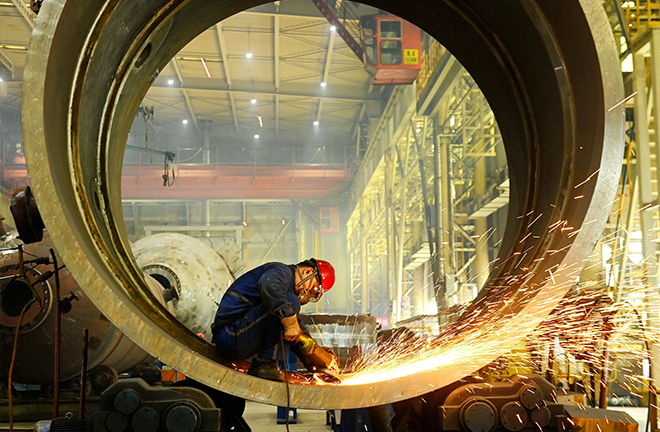Chinese economy poised for steady growth

A worker polishes components for petrochemical equipment at a heavy machinery factory in Qingdao, Shandong Province, on Oct. 31, 2024. Photo: IC PHOTO
On Dec. 23, 2024, a conference was held in Beijing to release the Blue Book of China’s Economy: Analysis and Forecast of China’s Economic Situation (2025) and examine the nation’s recent economic circumstances.
Economic performance in 2024
In his speech at the conference, Wang Changlin, vice president of the Chinese Academy of Social Sciences (CASS), remarked that 2024 had been an extraordinary year. Through more strategic macroeconomic adjustments, the timely implementation of a raft of incremental policies, and a focus on deepening reform and opening up, China’s economy demonstrated stable and improving performance. Industrial and export growth exceeded expectations, new quality productive forces developed steadily, risks in key areas were effectively mitigated, social expectations improved significantly, and the overall social environment remained stable. He emphasized that the foundations for economic stability have grown more robust, with increasing momentum for progress.
The Blue Book unveiled at the conference represents a significant research outcome from CASS’s Innovative Program for 2024. According to the Blue Book, the Chinese economy maintained its steady and progressive momentum in 2024, with notable structural highlights in economic operations and an accelerated pace of transformation and upgrading. China’s economy is projected to grow by 4.9% in 2024, with the Consumer Price Index (CPI) increasing by approximately 0.5%, aligning with the targets set at the beginning of the year.
The Blue Book points out that 2024 witnessed the steady development of new quality productive forces alongside extensive and profound shifts in China’s growth model. Industrial production, showcasing substantial resilience and advantages, maintained rapid growth. In the first three quarters of 2024, the cumulative year-on-year growth of industrial value-added output for enterprises above the designated size reached 5.8%, matching or even surpassing pre-pandemic growth rates. China’s robust industrial production system and strong production capacity have remained standout features of its economic performance.
Breakthroughs in key and core technologies marked significant progress, advancing technological self-reliance solidly. For instance, in semiconductor manufacturing, China has comprehensively mastered the core technology and processes for high-energy hydrogen ion implantation in power semiconductors, challenging foreign monopolies. Meanwhile, the development and expansion of emerging industries and business models has accelerated. High-tech sectors, particularly high-end equipment manufacturing, have emerged as key growth drivers of industry, achieving a globally leading position.
In addition, synergistic progress in digital intelligence and green transformation has gained momentum. The industrial internet now covers all major industrial categories, and industrial robots account for more than 50% of global installed capacity. China has maintained its global leadership in the production and sales of new energy vehicles for several consecutive years, as well as in the output of key segments of the photovoltaic industry chain. These advancements in the green and low-carbon sector have driven the overall industrial structure toward greater sustainability.
Growth prospects in 2025
Looking ahead to 2025, the Blue Book notes that from an international perspective, the world will continue to undergo profound changes unseen in a century. Challenges include a new wave of “Trump shock,” intensifying rivalries among major countries, potential new developments in the Russia-Ukraine crisis, and escalating tensions in the Middle East. While the global economy is expected to remain stable, growth momentum will likely be insufficient, with rising trade protectionism adding to the complexity, severity, and uncertainty of the external environment facing China.
The Blue Book identifies three favorable factors driving stable growth of China’s economy: strengthened policies, diminished hindrances, and deepened reforms. The cumulative effects of incremental policy measures will gradually emerge, providing robust support for economic expansion. Stabilization in the real estate and stock markets is expected to spur growth in consumption and investment, while further deepening reform comprehensively will further unlock endogenous growth potential.
The Blue Book recommends setting the 2025 growth target at approximately 5%. To achieve this, it advocates for a more proactive and effective macroeconomic policy framework. This includes strengthening fiscal policy to enhance efficiency, adopting a moderately loose monetary policy, and implementing social policies with a focus on warmth and improving the public’s sense of gain.
At the same time, economic work in 2025 should prioritize boosting consumption to expand domestic demand, accelerating the development of new quality productive forces, and invigorating business activities. Greater emphasis should also be placed on safeguarding and enhancing people’s livelihoods, expediting the implementation of landmark reform initiatives to achieve visible results, and proactively addressing risks in critical areas, according to the Blue Book.
The conference was hosted by CASS and organized by several institutions subordinate to CASS.
Edited by CHEN MIRONG
